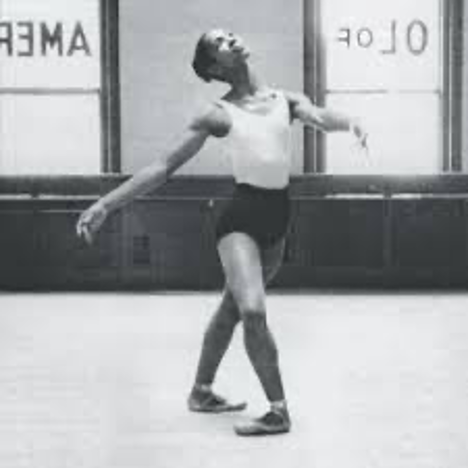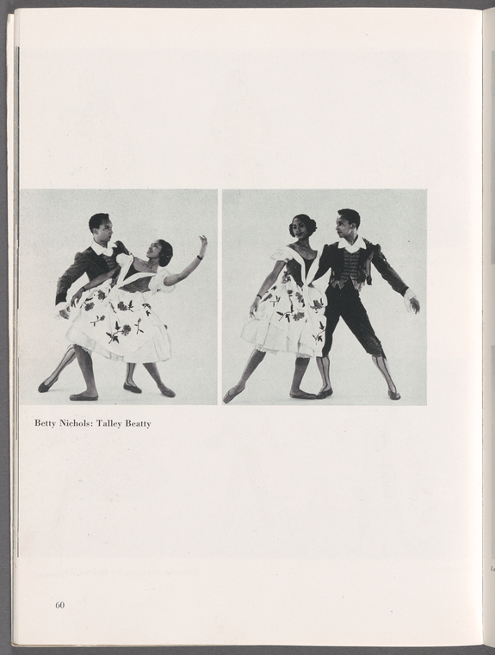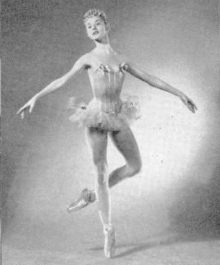Arthur Mitchell and Tanaquil Le Clercq

In 1956, New York City Ballet went to Europe on tour. Along with Le Clercq, Arthur Mitchell travelled as a member of the company; they performed ballets such as Western Symphony together. Just before one of their performances, Le Clercq reportedly told Mitchell she “felt a stiffness throughout her whole body; he told her to just stretch.” The night after that performance, Le Clercq was rushed to the hospital—she had been stricken with polio and was paralyzed, never to dance again.
After Le Clercq spent years in treatment, Balanchine divorced her in 1969. That same year, Arthur Mitchell founded Dance Theatre of Harlem, and he invited Le Clercq to teach at the school. Yvonne Delaney Mitchell, a woman who was among the first young students learning classical ballet at DTH, remembers one day when “this beautiful lady in a wheelchair was rolled in….We were introduced by Mitchell, who said something to the effect, ‘This is Tanaquil Le Clercq. She will be your teacher….Now places, everyone.’” Yvonne recalls that Le Clercq would “demonstrate the steps….by using her hands while softly counting out the beats.” Le Clercq continued to teach occasionally at Dance Theatre of Harlem, remaining engaged with ballet however she could. She had a close friendship with Mitchell, who in effect brought her back to life by giving her the opportunity to teach.
Betty Nichols and Tanaquil Le Clercq

Betty Nichols was the first Black dancer at School of American Ballet in 1943, before Arthur Mitchell was discovered by Kirstein. She expressed that she “thought there was considerable surprise, but the door was opened and that was it.” In 1946, Nichols became a member of Balanchine’s Ballet Society, an early iteration of NYCB, and performed in Blackface with Talley Beatty, another Black dancer at Ballet Society. She gained recognition through Ballet Society and became friends with Tanaquil (Tanny) Le Clercq, a beautiful French ballet dancer. Nichols thought highly of Le Clercq; she said “Tanny had been fantastic in Ballet Society…something original” and used to say to her “Kid, you’re great.”
In 1949, Nichols “decided that [she] was going to take every penny out of the bank and go on a three-month cultural vacation to Europe.” Her original companions, Hilda and Ana, were both unable to go, and as soon as Le Clercq heard, she called and said “Betty, can I take Ana’s place?” Thus, Nichols and Le Clercq embarked on a trip to Europe together.
When they were in Paris, Nichols says that she and Le Clercq were walking on the pave of St. Chapelle when they heard “Betty! Tanny!” It was Merce Cunningham and John Cage, who said “We’re going to have a recital. You’ve got to do it with us.” Nichols knew Cunningham from SAB, and Le Clercq had danced Cunningham’s Seasons at Ballet Society. In this way, the two ballerinas danced a trio with Cunningham, after which Nichols stayed in Paris, while Le Clercq returned to America on her mother’s insistence.

Source:
A Conversation with Betty Nichols, Ballet Review
More about Tanaquil Le Clercq

Tanaquil Le Clercq was a French ballet dancer and principal dancer with the New York City Ballet. Her dancing career ended abruptly when she was stricken with polio in Copenhagen during the company’s European tour in 1956. Eventually regaining most of the use of her arms and torso, she remained paralyzed from the waist down for the rest of her life.
When Le Clercq was fifteen years old, famed choreographer George Balanchine asked her to perform with him in a dance he choreographed for a polio charity benefit. In an eerie portent of things to come (Le Clercq would contract polio at twenty-seven and never recover mobility in her legs), he played a character named Polio, and Le Clercq was his victim who became paralyzed and fell to the floor. Then, children tossed dimes at her character, prompting her to get up and dance again.
Le Clercq was considered Balanchine’s first ballerina: she was trained in his style from childhood and was one of his most important muses, along with dancers like Maria Tallchief and, later on, Suzanne Farrell. During Le Clercq’s tenure with the company, Balanchine, Jerome Robbins, and Merce Cunningham all created roles for her.
Le Clercq’s life and career are profiled in the 2014 documentary film, Afternoon of a Faun: Tanaquil Le Clercq. Novelist Varley O’Connor created a fictional account of the relationship between Tanaquil LeClercq and George Balanchine in The Master’s Muse (Scribner 2012).
Source:

Aayushi Pramanik

